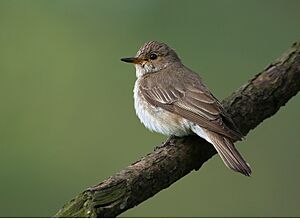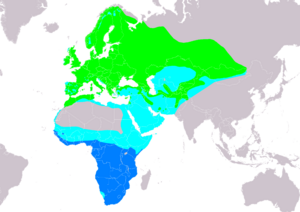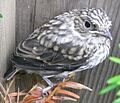Spotted flycatcher facts for kids
Quick facts for kids Spotted flycatcher |
|
|---|---|
 |
|
| In the Czech Republic | |
| Conservation status | |
| Scientific classification | |
| Genus: |
Muscicapa
|
| Species: |
striata
|
 |
|
| Range of M. striata Breeding Passage Non-breeding | |
| Synonyms | |
|
M. grisola L. |
|
The spotted flycatcher (Muscicapa striata) is a small bird that belongs to the Old World flycatcher family. These birds are known for catching insects while flying. They breed in most parts of Europe and in a large area called the Palearctic, stretching all the way to Siberia.
Spotted flycatchers are migratory birds. This means they travel long distances. They spend their winters in Africa and the southwestern parts of Asia. Sadly, their numbers are decreasing in some areas where they live.
This bird doesn't have very bright colors. It has long wings and a long tail. Adult spotted flycatchers have grey-brown feathers on their backs and whitish feathers on their bellies. Their head and chest have streaks, which is how they got their name "spotted." Their legs are short and black, and their beak is black and pointed, perfect for catching flying insects. Young flycatchers are browner than adults and have spots on their upper parts.
Contents
About the Spotted Flycatcher
The spotted flycatcher was first described by a German scientist named Peter Simon Pallas in 1764. He gave it the scientific name Motacilla striata. The name Muscicapa comes from two Latin words: musca, meaning "fly," and capere, meaning "to catch." The word striata also comes from Latin and means "streaked."
There are five different types, or subspecies, of the spotted flycatcher. All of them fly to southern Africa for the winter. Here are the main areas where they breed:
- M. s. striata: From Europe to western Siberia and northwest Africa.
- M. s. inexpectata: Found in Crimea, which is in southern Ukraine.
- M. s. neumanni: Lives on islands in the Aegean Sea, through the Middle East, the Caucasus mountains, northern Iran, and central Siberia.
- M. s. sarudnyi: From eastern Iran and Turkmenistan to the mountains of central Asia and northern Pakistan.
- M. s. mongola: Found in Mongolia and south-central Siberia.
What They Look Like
The spotted flycatcher is a small, slender bird. It is about 14.5 cm (5.7 in) long and weighs between 14–20 g (0.49–0.71 oz). It has dull grey-brown feathers on its back and off-white feathers underneath. Its head, throat, and chest have brown streaks. The feathers on its wings and tail have thin, pale edges.
Male and female spotted flycatchers look very similar. Young birds, called juveniles, have yellowish-brown spots on their backs and scaly brown spots on their bellies.
How They Behave
Spotted flycatchers like to hunt from high places. They often sit on a branch or a fence where they can see well. When they spot a flying insect, they quickly fly out to catch it. Then, they often return to the same spot. Their upright way of sitting is very easy to recognize.
Most small birds change their flight feathers in a certain order. They usually start with the feathers closest to their body and work their way outwards. But the spotted flycatcher is a bit different! It replaces its outer flight feathers before the ones closer to its body.
The call of a spotted flycatcher is a soft, high-pitched sound. It sounds like a drawn-out tssssseeeeeppppp that gently goes down in pitch.
Reproduction and Nesting
These birds prefer to live in woodlands with trees that lose their leaves, as well as in parks and gardens. They like open areas with scattered trees. They build an open nest in a hidden spot, often against a wall. They are also happy to use a nest box that is open at the front. A female flycatcher usually lays 4 to 6 eggs.
Most European birds cannot tell the difference between their own eggs and the eggs of other birds. However, birds that are often tricked by the common cuckoo have learned to recognize the cuckoo's eggs. This helps them protect their nests. The spotted flycatcher is very good at recognizing different eggs. Scientists think that the cuckoo might have tried to lay its eggs in flycatcher nests a long time ago. But the flycatchers became so good at spotting the cuckoo's eggs that the cuckoo stopped bothering them.
Who Hunts Them
A study in southern England looked at spotted flycatcher nests. It found that about one-third of the nests were attacked by predators. The Eurasian jay (Garrulus glandarius) was the most common bird predator. Jays would eat both the eggs and the young chicks. Cats also hunted a small number of nests.
Images for kids








